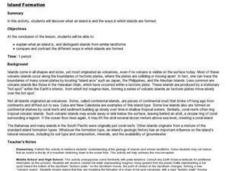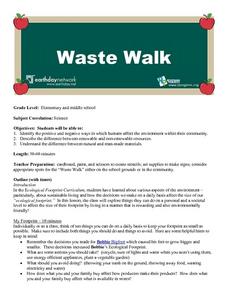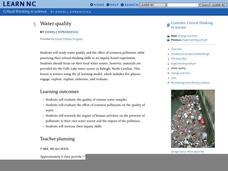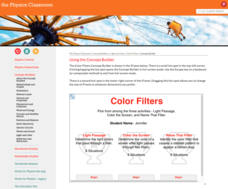Curated OER
Causes of Volcanoes
For this volcano worksheet, students fill in a chart with sketches of the three causes of volcanoes, the type of lava from each, a description and any features of each and examples of each.
Curated OER
What's The Difference?
Students identify geologic features that are associated with volcanoes. In this volcanic exploration lesson students compare and contrast convergent and divergent volcanoes and are able to explain why some erupt more explosively.
Curated OER
How Hot is that Planet?
In this planet worksheet, high schoolers read about finding the temperature of a planet using the distance to its star, its reflectivity and the luminosity of the star. Students use a given equation to determine the...
Curated OER
Volcanoes
Students study volcanoes. In this volcanoes instructional activity, students read several volcano paragraphs and study the pictures or diagrams. Students then make an erupting volcano, complete website research about volcanoes, and...
Curated OER
Preserving Paradise
Students read an online article to study about the death of Joan Root. They research endangered ecosystems around the world and design ad campaigns to create public awareness.
Curated OER
Vocabulary for Earthquakes and Volcanoes
In this plate tectonics learning exercise, students define 27 terms associated with earthquakes and volcanoes such as subduction zone, mantle, and divergent plate.
Curated OER
Island Formation
Students create models of how islands are formed by hot spots and then write a summary of their observations and of how they think their model relates to volcanic hot spots and island formation.
Curated OER
Photojournalism and composition
Pupils explore photos they find desirable. They read the section of the book, How to Take Great Photographs With Any Camera, by Jerry Hughes, on Composition. They discuss, the Rule of Thirds, Hot Spots, Framing, and Cropping.
Curated OER
Environment: Waste Walk
Young scholars assess the positive and negative affects of humans on the environment. The lesson explores ways in which individuals and societies can reduce the negative impact on the environment. By taking a "waste walk" around their...
Coastal Carolina University
Osmosis and Diffusion Lab: Honey I Blew Up the Bear
Beginning biologists explore passive transport through two demonstrations and a hands-on inquiry. Spray air freshener from one spot in the classroom and have class members raise their hands as the scent reaches them. Also, place a teabag...
Curated OER
Water Quality
For this unit of lessons, students examine the quality of water. They create poems and make observations about the quality of water. They also examine hot spots and the quality of water in the Great Lakes.
Curated OER
Volcano!
Students develop problem solving techniques through movement. They coming to PE class, are told that a giant volcano has erupted and there is hot lava everywhere. They need to get to island (tumbling mat or mats) on other side of playing...
Curated OER
The Sun
In this science worksheet, students answer 4 questions about the sun. Students also circle the sun spots on an illustration of the stun.
ARKive
Adaptations to Arid Habitats
How do plants and animals survive in habitats with very little water? Explore arid ecosystems and the way their inhabitants have adapted with a lesson and science experiment. After kids listen to a presentation about adaptation, they...
Curated OER
The Summer Sun is Hot, Hot, Hot
Young scholars recognize the short vowel o in written and spoken language. Through listening and matching activities, they discriminate the short vowel /o/ from other vowel phonemes. Students associate /o/ with its letter representation...
Curated OER
What Makes the Wind Blow?
Student study the properties of wind. They make a miniature hot-air balloon and compose diamond-shaped poems about the wind. They explain that as the sun warms air around the earth, the air rises. Colder air then moves in to fill the...
Curated OER
Where's the Beach?
Students use beach profile data to analyze how erosion and sediment transport changed seashore slopes. In this geology lesson, students plot the data provided and analyze erosion patterns. They also assess coastal erosion management...
Physics Classroom
The L.O.S.T. Art of Image Description - Converging Lenses
Magnifying glasses and cameras often use converging lenses, but how do they alter an image? Pupils discover a lens, axis, and object arrow before identifying four characteristics of the resulting image. They label the location,...
Physics Classroom
Total Internal Reflection
Scholars work through three different activities applying their knowledge of total internal reflection (TIR). First, they simply identify which diagrams create TIR and which don't. Next, they match different types of boundary behaviors...
Physics Classroom
Spectrum
Scholars relate each of the colors in the spectrum, except indigo, by comparing their frequencies, wavelengths, and energy levels. Then, they compare each section of the electromagnetic spectrum when considering the same three variables.
Physics Classroom
Light Intensity
Light intensity varies by the strength of the light bulb as well as the distance to the light bulb. Pupils apply these concepts independently at first. They must solve for the light intensity as either the distance or the wattage of the...
Physics Classroom
If This, Then That: Color
The dress color debate of 2015 taught the importance of understanding how we see light. Scholars view a shirt under two different colored lights and then must predict what color the shirt will appear under a third light. They apply color...
Physics Classroom
Color Pigments
Objects contain pigments that selectively absorb a wavelength of light, and our eyes only observe a very small range of these wavelengths. Scholars apply these two facts to three different activities. They identify the pigment in an...
Physics Classroom
Color Filters
Filters provide amusing changes to images in applications other than just Instagram! High school pupils apply their knowledge of colored filters to three different interactive sets of puzzles. They identify light colors that pass through...
Other popular searches
- Endangered Hot Spots
- Volcanoes Hot Spots
- Volcanic Hot Spots
- Hawaiian Hot Spots
- Earth Science Hot Spots
- Hawaii Hot Spot
- Hot Spots Forming Islands
- Haiwiian Hot Spots
- Hot Spot Plate Movement
- Hot Spots Magma
- Cold War Hot Spots
- Hot Spot Volcano























